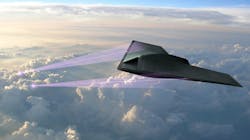DARPA eyes curved high-performance infrared focal plane array sensors for military and aerospace uses
ARLINGTON, Va. – U.S. Military researchers are asking industry to develop curved large-format cryogenically cooled infrared focal plane array electro-optical sensors for a wide variety of military and aerospace applications.
Officials of the U.S. Defense Advanced Research Projects Agency (DARPA) in Arlington, Va., issued a solicitation Friday (HR001119S0078) for the FOcal arrays for Curved Infrared Imagers (FOCII) project.
FOCII seeks to develop two kinds of curved longwave and midwave infrared focal plane arrays:
-- an existing state-of-the-art 2,000-by-2,000-pixel 55-millimeter-diagonal cryogenically cooled detectors with a radius of curvature of 70 millimeters without any change to the underlying array design process; and
Related: DARPA seeks to create lightweight fisheye optical imaging sensor with 120-degree field
-- 2,000-by-2,000-pixel 35-millimeter-diagonal cryogenically cooled sensors with an 12.5-millimeter radius of curvature using structured designs.
Nearly all military fielded imaging systems use detector arrays fabricated using planar processes developed for electronic integrated circuits, which requires large and complex optics to correct for spherical aberrations. Recent work, moreover, has developed small-area curved focal plane arrays for visible-light cameras.
The FOCII project seeks to extend this capability to large- and small-format cryogenically cooled mediumwave and longwave imagers with extreme radii of curvature.
The ability to created curved large- and small-format cryogenically cooled mediumwave and longwave imagers could enable military systems designers to conform high-performance infrared sensors to the shapes of aircraft fuselages, the skin of missiles, and other curved surfaces.
Related: VIEWPOINT: Careful design can alleviate angle effects in infrared bandpass filters
While curved focal plane arrays and curved imagers have been attempted in the past, the approaches used were not able to produce commercially scalable, large-format devices with small radii of curvature.
Several organizations developed techniques to curve commercial arrays smaller than 20 millimeters diagonal to a small radius of curvature of about 50 to 70 millimeters.
These curved focal plane arrays, however, operated at room temperature and primarily imaged only visible light. Though very small radii of curvature are possible with focal plane arrays that use nontraditional flexible absorbing materials combined with flexible electronics, imaging sensitivity, noise, and resolution were significantly worse because of the inherently poorer electrical properties, immature processing, and low-fill factor of flexible materials.
Lastly, compound imagers arraying several micro-imaging systems into a curved imaging plane with a common objective lens have been demonstrated with high resolution and high sensitivity, yet these were large, costly, and complex.
Instead, the FOCII project seeks to develop technologies for curving existing large-format, high-performance infrared focal plane arrays to a small radius of curvature to make the most of performance and curve smaller format focal plane arrays to an extreme radius of curvature to enable the smallest form factors possible while maintaining exquisite performance.
FOCII has three phases that will pursue two technical areas over four years: curving state-of-the-art focal plane arrays; and structured focal plane arrays. The first yearlong phase focuses on mechanical structures; the optional 18-month second phase focuses on integrated focal plane arrays; and the optional third 18-month third phase will focus on imaging demonstrations.
Companies interested should submit abstracts no later than 3 Sept. 2019, and full proposals by 18 Oct. 2019 to the DARPA BAA Website at https://baa.darpa.mil.
Email questions or concerns to DARPA's Whitney Mason at [email protected] More information is online at https://www.fbo.gov/spg/ODA/DARPA/CMO/HR001119S0078/listing.html.

